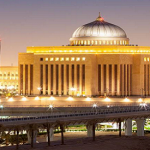Riyadh has the feel of a city which is changing – perhaps because of the many construction projects so visible everywhere. They are, in fact, just physical manifestations of a major transformation underway in the Kingdom of Saudi Arabia, enshrined in the Vision 2030 document. This was first published in 2016, an all-encompassing vision driven by the Crown Prince Muhammad bin Salman (MBS).
Externally too, Saudi Arabia’s alignments are shifting, and India is a key player. From a one-way dependency on Saudi Arabia for energy supplies and remittances, India is now becoming equally important to the Kingdom’s long-term financial well-being.
These shifts are discernible in Saudi society and its economy, and will soon be visible in its security arrangements.
Social changes
The most perceptible change in Saudi Arabia is social, particularly in the place of women in the public space, reforms brought about by MBS. Restaurants, food courts and public spaces are no longer gender-segregated. Till early this year, separate seating areas for families (groups with women) and groups of men were mandatory. No more. Foreigners need no longer follow the local dress code (the abaya), possibly in preparation for Saudi Arabia’s G20 Presidency next year in 2020, when hundreds of foreigners will come to the Kingdom for multilateral meetings. In the new malls being built in Riyadh, previously-banned movie theatres are under construction.
With a young population whose median age is 30, Saudi Arabia must provide opportunities, or risk the unrest now so common in West Asia. The Kingdom is therefore investing heavily in education and research, with a central aim of the Vision 2030 being the recognition of five Saudi universities in the top global institutions by 2030.
Several new education/research institutions have been established in the past few years. Among the most prestigious is the King Abdullah Petroleum Studies and Research Center or KAPSARC, which opened its doors in 2013 with an endowment of $4 billion. KAPSARC sits right next to the Princess Nora bint Abdul Rehman University, the largest women’s university in the world with 80,000 students – all women – offering degrees in sciences, business administration and information sciences. The new campus, inaugurated in 2011, is large enough to require its own metro-rail. A few hundred kilometres away, in the Makkah province, is the King Abdullah University of Science and Technology, spread over a 3,600-hectare campus, with an enviable multi-billion dollar endowment.
These universities are primarily for Saudi youth, skilling them for the future. They will likely replace some of the white-collar workers in Saudi Arabia, most of whom are currently foreign. The impact of Vision 2030 will certainly be felt by some of the top-end of the kingdom’s 9 million foreign workers, of which the 3 million Indians comprise the largest cohort.
Economic changes
Many of the major, on-going infrastructure projects in Riyadh are a legacy of the $100 per barrel oil price, when the Kingdom was awash in cash. With oil prices down almost by half, the Kingdom is working to diversify its economy – a key theme in the vision 2030 document. The most ambitious example of that is the King Abdullah Financial District, a 3-million square metre commercial space in Riyadh which is now trying to transform itself into a special zone with eased regulations and laws, visa exemptions and direct connectivity to the airport – and no ban on alcohol.
Security:
Security is perhaps the trickiest challenge for the Saudi government. The war in Yemen is not going well. The attack on Aramco’s Abqaiq oil processing plant, ostensibly by Iran or its proxies, which hit 5 million barrels of world oil supply, came as a shock. The lack of response from its closest ally, the U.S., devalues the security guarantees that America has provided since 1945. Nor does the U.S. have much leverage on Iran, because of all-pervasive sanctions which puts Iran beyond U.S. reach. A military dispute with Iran is now clearly not possible.
Under these circumstances, Saudi Arabia will have to find ways to co-exist with Iran, and look beyond the U.S. for other security partners. China, Russia and India, which have security and economic partnerships with Iran, are the new potential partners.
The October 1 visit by National Security Advisor Ajit Doval to Saudi Arabia, followed by a possible state visit by Prime Minister Modi to the Kingdom, later this month, points to such new beginnings. Saudi Aramco’s proposed $15 billion investment in Reliance Industries and plans for an additional $100 billion in investments in India, shows this will be a substantive partnership.
Amit Bhandari is Fellow, Energy and Environment Studies Programme, Gateway House.
This blog was exclusively written for Gateway House: Indian Council on Global Relations. You can read more exclusive content here.
For interview requests with the author, or for permission to republish, please contact outreach@gatewayhouse.in
© Copyright 2019 Gateway House: Indian Council on Global Relations. All rights reserved. Any unauthorized copying or reproduction is strictly prohibited.


